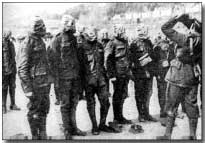Primary Documents - German Statement on the Use of Poison Gas at the Second Battle of Ypres, 25 June 1915
 Reproduced below is the
official German statement - issued via the German press - released in the
wake of international revulsion at the German use of
poison gas
at the start of the
Second Battle of Ypres on 22
April 1915.
Reproduced below is the
official German statement - issued via the German press - released in the
wake of international revulsion at the German use of
poison gas
at the start of the
Second Battle of Ypres on 22
April 1915.
The essence of the statement was straightforward: French criticism of Germany's use of poison gas was hypocritical given that France had itself pioneered use of gas some months earlier. To substantiate Germany's claim the text of a French War Ministry memo dated 21 February 1915 - i.e. prior to the opening of 2nd Ypres - was published.
First Gas Attack at Ypres
Official German Press Report, 25 June 1915
For every one who has kept an unbiased judgment, the official assertions of the strictly accurate and truthful German military administration will be sufficient to prove the prior use of asphyxiating gases by our opponents.
On April 16th the French were making increased use of asphyxiating bombs. But let whoever still doubts, consider the following instructions for the systematic preparation of this means of warfare by the French, issued by the French War Ministry, dated February 21, 1915:
Ministry of War, February 21, 1915
Remarks concerning shells with stupefying gases:
The so-called shells with stupefying gases that are being manufactured by our central factories contain a fluid which streams forth after the explosion, in the form of vapours that irritate the eyes, nose, and throat.
There are two kinds: hand grenades and cartridges.
Hand Grenades. The grenades have the form of an egg; their diameter in the middle is six centimetres, their height twelve centimetres, their weight 400 grams. They are intended for short distances, and have an appliance for throwing by hand. They are equipped with an inscription giving directions for use. They are lighted with a small bit of material for friction pasted on the directions, after which they must be thrown away. The explosion follows seven seconds after lighting. A small cover of brass and a top screwed on protect the lighted matter. Their purpose is to make untenable the surroundings of the place where they burst. Their effect is often considerably impaired by a strong rising wind.
Cartridges. The cartridges have a cylindrical form. Their diameter is twenty-eight millimetres, their height ten centimetres, their weight 200 grams. They are intended for use at longer distances than can be negotiated with the hand grenades. With an angle of twenty-five degrees at departure, they will carry 230 metres. They have central lighting facilities and are fired with ignition bullet guns. The powder lights a little internal ignition mass by means of which the cartridges are caused to explode five seconds after leaving the rifle. The cartridges have the same purpose as the hand grenades but because of their very small amount of fluid they must be fired in great numbers at the same time.
Precautionary measures to be observed in attacks on trenches into which shells with asphyxiating gases have been thrown:- The vapours spread by means of the shells with asphyxiating gases are not deadly, at least when small quantities are used and their effect is only momentary. The duration of the effect depends upon the atmospheric conditions.
It is advisable therefore to attack the trenches into which such hand grenades have been thrown and which the enemy has nevertheless not evacuated before the vapours are completely dissipated. The attacking troops, moreover, must wear protective goggles and in addition be instructed that the unpleasant sensations in nose and throat are not dangerous and involve no lasting disturbance.
Here we have a conclusive proof that the French in their State workshops manufactured shells with asphyxiating gases fully half a year ago at least.
The number must have been so large that the French War Ministry at last found itself obliged to issue written instructions concerning the use of this means of warfare. What hypocrisy when the same people grow "indignant" because the Germans much later followed them on the path they had pointed out!
Very characteristic is the twist of the French official direction: "The vapours spread by the shells with asphyxiating gases are not deadly, at least not when used in small quantities." It is precisely this limitation that contains the unequivocal confession that the French asphyxiating gases work with deadly effect when used in large quantities.
Source: Source Records of the Great War, Vol. III, ed. Charles F. Horne, National Alumni 1923
A "dope can" was a metal syringe containing petrol for priming an aircraft engine.
- Did you know?
